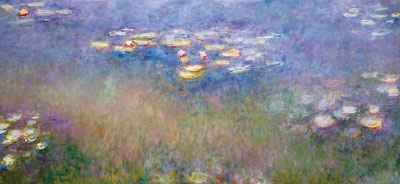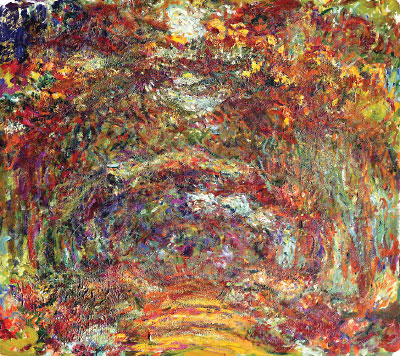Experience the Extraordinary at de Young Museum
Abstract
Take a side trip from the Annual Meeting to view more than 20 paintings from Monet’s beloved “Water Lilies” series at a special exhibition, “Monet: The Late Years,” at San Francisco’s de Young Museum.
How do you take in the world around you? Are there colors and objects that speak to you more loudly than others? What would it look like if everyday objects turned “wild”? San Francisco’s de Young Museum invites you to consider these questions and more with a walk through several special art exhibits that will be on display during the Annual Meeting.

One of Claude Monet’s beloved “Water Lilies” (1915-1926) paintings will be part of a special exhibit at the de Young Museum during APA’s 2019 Annual Meeting.
First a little background: The city’s oldest museum, named after newspaper magnate M. H. de Young, got its start in 1894 at Golden Gate Park as part of the city’s California Midwinter International Exposition. Although the original building that housed the museum’s priceless collections was replaced with a modern, state-of-the-art facility in 2005, landmarks from the museum’s past remain on site. These include a whimsically named place called the Pool of Enchantment and large ornate vases and sphinxes that were part of the original 1894 fair.
Today’s de Young Museum building is a contemporary architectural landmark in San Francisco, offering sweeping views of the city from its dramatic 144-foot tower observation level. The building is mostly constructed of copper, and its unique design was created with the idea that the “building would be enhanced not only by sunlight but also by San Francisco’s constant fog,” according to its architects.
The museum houses permanent collections of American paintings, and sculpture, along with an array of international pieces and artifacts from ancient civilizations.
Annual Meeting attendees who are French Impressionism fans will arrive just in time to take in the exhibit titled “Monet: The Final Years,” which ends on May 25. The special exhibition features some 60 paintings by Claude Monet, dating mainly from 1913 up to his death in 1926.

“Monet: The Final Years” traces the French impressionist’s style as it moves toward increasingly bold and abstract works, as in his “Path Under the Rose Arches,” 1918–1924.
During his late years, the well-traveled Monet stayed close to home, inspired by his own garden at Giverny, a village located some 45 miles northwest of Paris. With its evolving scenery of flower beds, footpaths, willows, and wisteria, the garden became a personal laboratory for the artist’s study of natural phenomena.
The exhibit will showcase many extraordinary and unfamiliar works as it traces the reinvention of Monet’s style to increasingly bold and abstract works. It will showcase pieces never before seen in the United States, drawing from public and private collections in the United States, Asia, and Europe, including works on loan from the Musée Marmottan Monet in Paris.
Some 20 paintings from Monet’s beloved “Water Lilies,” or Nymphéas series, which is among the most recognized and celebrated works of the 20th century, will also be on display. This series was the main focus of Monet’s artistic production during the final years of his life and was hugely influential to many generations of artists.
Also at the de Young during the Annual Meeting, American contemporary artist Matt Mullican will take over the atrium for his first solo exhibition in the United States in 20 years. “Between Sign and Subject” will feature flags, bulletin boards, light boxes, and a wall of rubbings that will draw visitors into a universe of symbols and pictograms that chart Mullican’s experience of being in the world.

Works by American contemporary artist Matt Mullican will be on display in the atrium, including this piece “Untitled (Center Subject Over Center Language),” 2016.
Over the past four decades, Mullican has created a body of work encompassing drawing, collage, painting, photography, video, sculpture, and installation—as well as performance art under hypnosis. Trying to “organize the world” and make sense of his existence, Mullican invented a personal cosmology in which colors indicate different orders or “worlds.”
Mullican’s de Young installation comprises 50 works, including rubbings made by transferring the image of a glass etching onto canvas with acrylic gouache and oil stick; light boxes with computer graphics that map his five “worlds”; and bulletin boards with found household objects, studio drawings, comics, and charts that represent the visual system with which Mullican attempts to categorize the world around him.
One other exhibit on display through mid-June, “Ordinary Objects/Wild Things,” represents the still-life genre. While some of the etchings are typical still lifes (a ceramic vessel arranged credibly, for instance), in others, the everyday articles have turned “wild” and have been redesigned and repositioned for unconventional and unexpected use. For example, visitors will encounter a painting of a giant three-pronged plug and wonder: is it a buoy or perhaps a floating building, or merely a source of power? ■
The de Young Museum is located at Golden Gate Park, 50 Hagiwara Tea Garden Drive, San Francisco. More information can be obtained here or by calling (415) 750-3600.



